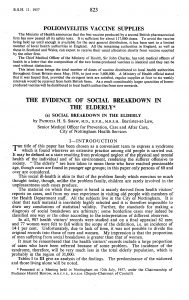 At the NIHR Policy Research Unit in Health and Social Care Workforce we are undertaking two studies examining self-neglect, both funded by the NIHR School for Social Care Research. In an article published in The Journal of Adult Protection, for the project examining Adult Safeguarding Responses to Homelessness and Self-neglect, Stephen Martineau goes back to three pioneering research papers on self-neglect to consider what, if anything, they can feed into current debates. (787 words)
At the NIHR Policy Research Unit in Health and Social Care Workforce we are undertaking two studies examining self-neglect, both funded by the NIHR School for Social Care Research. In an article published in The Journal of Adult Protection, for the project examining Adult Safeguarding Responses to Homelessness and Self-neglect, Stephen Martineau goes back to three pioneering research papers on self-neglect to consider what, if anything, they can feed into current debates. (787 words)
While conducting a review of the self-neglect literature during this year, references to two early papers on the topic have come up repeatedly. The first, published in the British Medical Journal in 1966, by Macmillan and Shaw, is often described as the seminal academic paper in this field and drew on cases in Nottingham. The other is the Diogenes Syndrome article, by Clark, Mankikar and Gray, published in The Lancet in 1975; it derived from a study conducted in a Brighton hospital. Our new Journal of Adult Protection article examines these two articles plus a third, again by Shaw and Macmillan. This one dates from 1957 and, though it did not use the term self-neglect (rather, social breakdown in the elderly), it is the most vivid and interesting of the three.
There is a good deal of research interest in self-neglect at present. Following consultation with, and a survey of, practitioners, carers and service users (suggested by our Unit), the James Lind Alliance (2018) Priority Setting Research Partnership on Adult Social Work recommended that the topic should be a research priority. As well as the Unit’s two studies (details below), the NIHR has a call out for a study of self-neglect in the community (closing 28 January 2021). The need for such research is reinforced by Michael Preston-Shoot and colleagues’ new national study of Safeguarding Adults Reviews that were conducted between April 2017 – March 2019. SARs are commissioned where questions are raised about the way agencies involved in safeguarding have worked together in individual cases: among the 231 reviews the authors analysed, self-neglect constituted the most common type of abuse/neglect (featuring in 45% of the reviews).
The national policy context for this research is provided by the statutory guidance to the Care Act 2014, which includes reference to self-neglect (*see note below for a brief history of this inclusion). The guidance counsels that it may be appropriate to manage serious cases within adult safeguarding; the multi-agency protocols that are integral to safeguarding practice are thought to be a good fit with the kind of complexity self-neglect can involve (see para 14.141 of the current version of the guidance). At the same time, the 2014 Act abolished the power of compulsory removal in section 47 National Assistance Act 1948, which embodied an earlier approach to self-neglect—though evidence of its use was sparse and the authors of the three papers under review did not favour resorting to it.

The home of Langley and Homer Collyer being inspected by the police in 1947 – an example of hoarding referred to in the Unit’s new article
Our new Journal of Adult Protection article is in three parts. In addition to reporting on the findings of the three early papers, ‘What is self-neglect?’ looks at recent refinements in classification around hoarding and severe domestic squalor as well as various other definitional aspects. The second part, ‘a completely uncivilized state of affairs’, is a brief reflection on the importance of social context and social norms in this topic. And finally, ‘Refusals and interventions’ recounts challenges in engagement and intervention, described both in the early research but also more recently, particularly where the person’s self-neglect is seemingly exacerbated by a reluctance to accept assistance.
Stephen Martineau is research associate at the Policy Research Unit in Health and Social Care Workforce, King’s College London.
The Journal of Adult Protection | Author copy of the article for non-subscribers
*When the Care Act 2014’s draft statutory guidance was put out to consultation in summer 2014, it contained only one passing mention of self-neglect (in a case study). However, following the consultation process, the guidance’s first edition (October 2014) newly classified self-neglect among its list of forms of abuse and neglect in the safeguarding portion of the document.
In December 2014, the Health and Social Care Information Centre (precursor to NHS Digital) initiated its own consultation on local authority reporting requirements under the new statute. And in March 2015, a month before the safeguarding elements of the 2014 Act came into force, the Centre pointed out ‘that it is likely that most self-neglect cases will not be the subject of a Section 42 enquiry’ (p. 20). (Section 42 Care Act 2014 sets out the local authority duty to conduct safeguarding enquiries.)
A year later, in March 2016, a revised edition of the statutory guidance fleshed out this observation. It added to the October 2014 description of self-neglect (‘a wide range of behaviour neglecting to care for one’s personal hygiene, health or surroundings and includes behaviour such as hoarding’) the following text, which remains applicable today:
‘It should be noted that self-neglect may not prompt a section 42 enquiry. An assessment should be made on a case by case basis. A decision on whether a response is required under safeguarding will depend on the adult’s ability to protect themselves by controlling their own behaviour. There may come a point when they are no longer able to do this, without external support.’ (para 14.17)
***
This blog and the Journal of Adult Protection article derive from the study, ‘Opening the “Too Difficult Box”: Strengthening Adult Safeguarding Responses to Homelessness and Self-neglect’. The study represents independent research (Ref. P141) funded by the National Institute for Health Research (NIHR) School for Social Care Research (NIHR SSCR). The views expressed are those of the author and not necessarily those of the NIHR SSCR, NIHR or Department of Health and Social Care.
(The other NIHR SSCR funded study at the Unit is: Social care responses to self-neglect and hoarding among older people: what works in practice?)
Three papers under review in the JAP article
Clark, A. N. G., Mankikar, G. D. and Gray, I. (1975) ‘Diogenes syndrome: a clinical study of gross neglect in old age’, The Lancet, Vol. 305 No. 7903, pp. 366-368.
Macmillan, D. and Shaw, P. (1966) ‘Senile breakdown in standards of personal and environmental cleanliness’, British Medical Journal, Vol. 2 No. 5521, pp. 1032-1037.
Shaw, P. H. S. and Macmillan, D. (1957) ‘The Evidence of Social Breakdown in the Elderly: (a) Social Breakdown in the Elderly; (b) Psychiatric Aspects of Social Breakdown in the Elderly’, Journal (Royal Society of Health), Vol. 77 No. 11, pp. 823-836. (The JAP article focuses on part (a) of the 1957 paper, written by Patricia Shaw.)
